Subaru Forester: Engine oil
NOTE
- The engine oil consumption rate is
not stabilized, and therefore cannot be
determined until the vehicle has traveled
at least several thousand miles
(kilometers). Even after break-in, when
the vehicle is used under severe driving
conditions such as those mentioned
in the Warranty and Maintenance
Booklet, engine oil is consumed
or deteriorated more quickly than under
normal driving conditions. If you
drive your vehicle under these severe
conditions, you should check the oil
level at least at every second fuel fill-up
time, and change the oil more frequently.
Please refer to the Warranty and Maintenance Booklet for more details.
- If the oil consumption rate seems abnormally high after the break-in period, for example more than 1 quart per 1,200 miles or 1 liter per 2,000 kilometers, contact your SUBARU dealer.
Checking the oil level
Check the engine oil level at each fuel stop.
1. Park the vehicle on a level surface and stop the engine.
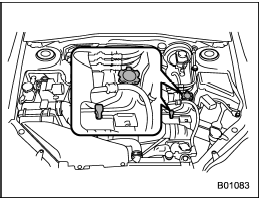
Turbo models
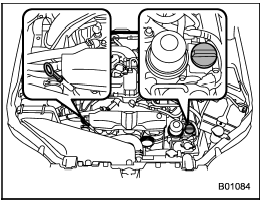
Non-turbo models
2. Pull out the level gauge, wipe it clean, and insert it again.
3. Be sure the level gauge is correctly inserted until it stops.
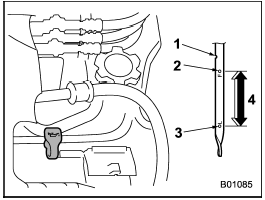
Turbo models
1) Notch
2) Upper level
3) Lower level
4) Approximately 1.1 US qt (1.0 liter, 0.9
Imp qt) from lower level to upper level
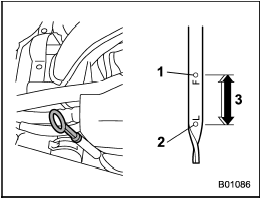
Non-turbo models
1) Upper level
2) Lower level
3) Approximately 1.1 US qt (1.0 liter, 0.9
Imp qt) from lower level to upper level
4. Pull out the level gauge again and check the oil level on it. If it is below the lower level, add oil to bring the level up to the upper level.

- Use only engine oil with the recommended grade and viscosity.
- Be careful not to spill engine oil when adding it. If oil touches the exhaust pipe, it may cause a bad smell, smoke, and/or a fire. If engine oil gets on the exhaust pipe, be sure to wipe it off.
If you check the oil level just after stopping the engine, wait a few minutes for the oil to drain back into the oil pan before checking the level.
Just after driving or while the engine is warm, the engine oil level reading may be in a range between the upper level and the notch mark. This is caused by thermal expansion of the engine oil.
To prevent overfilling the engine oil, do not add any additional oil above the upper level when the engine is cold.
Changing the oil and oil filter
Change the oil and oil filter according to the maintenance schedule in the “Warranty and Maintenance Booklet”.
The engine oil and oil filter must be changed more frequently than listed in the maintenance schedule when driving on dusty roads, when short trips are frequently made, or when driving in extremely cold weather.
NOTE
Changing the engine oil and oil filter
should be performed by a properlytrained
expert. It is recommended that
you have this service performed by
your SUBARU dealer.
1. Warm up the engine by letting the engine idle for approximately 10 minutes to ease draining the engine oil.
2. Park the vehicle on a level surface and stop the engine.
3. Remove the oil filler cap.
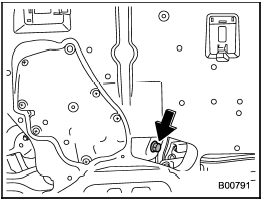
Turbo models
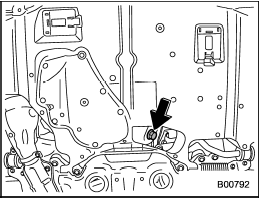
Non-turbo models
4. Drain out the engine oil by removing the drain plug while the engine is still warm. The used oil should be drained into an appropriate container and disposed of properly.

Be careful not to burn yourself with hot engine oil.
5. Wipe the seating surface of the drain plug with a clean cloth and tighten it securely with a new sealing washer after the oil has completely drained out.
6. Remove the under cover (turbo models).
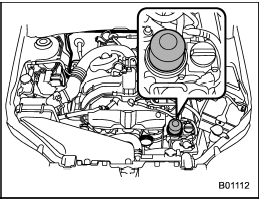
Non-turbo models
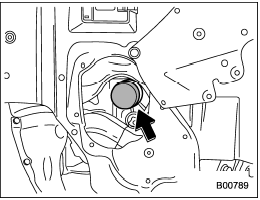
Turbo models
7. Remove the oil filter with an oil filter wrench.
8. Before installing a new oil filter, apply a thin coat of engine oil to the seal.
9. Clean the rubber seal seating area of the bottom of engine and install the oil filter by hand turning. Be careful not to twist or damage the seal.
10. Tighten the oil filter by the amount indicated in the following table after the seal makes contact with the bottom of engine.
Turbo models

Non-turbo models


- Never over tighten the oil filter because that can result in an oil leak.
- Thoroughly wipe off any engine oil that has spilled over the exhaust pipe and/or under-cover.
If spilled oil is not promptly wiped up, the oil could cause a fire.
11. Reinstall under cover (turbo models).
12. Pour engine oil through the filler neck.
For the oil capacity (guideline), refer to “Engine oil”.
The oil quantity indicated above is only guideline.
The necessary quantity of oil depends on the quantity of oil that has been drained.
The quantity of drained oil differs slightly depending on the temperature of the oil and the time the oil is left flowing out. After refilling the engine with oil, therefore, you must use the level gauge to confirm that the level is correct.
13. Start the engine and make sure that no oil leaks appear around the filter’s rubber seal and drain plug.
14. Run the engine until it reaches the normal operating temperature. Then stop the engine and wait a few minutes to allow the oil drain back. Check the oil level again and if necessary, add more engine oil.

Be careful not to spill engine oil when adding it. If oil touches the exhaust pipe, it may cause a bad smell, smoke, and/or a fire.
Recommended grade and viscosity

Use only engine oil with the recommended grade and viscosity.
Refer to “Engine oil”.
NOTE
Engine oil viscosity (thickness) affects
fuel economy. Oils of lower viscosity
provide better fuel economy. However,
in hot weather, oil of higher viscosity is
required to properly lubricate the engine.
Synthetic oil
You should use synthetic engine oil that meets the same requirements given for conventional engine oil. When using synthetic oil, you must use oil of the same classification, viscosity and grade shown in this Owner’s Manual. Refer to “Engine oil”. Also, you must follow the oil and filter changing intervals shown in the Warranty and Maintenance booklet.
NOTE
Synthetic oil of the grade and viscosity
noted in chapter 12 is the required
engine oil for optimum engine performance.
Conventional oil may be used if synthetic oil is unavailable.
See also:
Recommended cold tire inflation pressures
Tire label located on the driver's side of
the center pillar outer panel gives the
cold tire pressures recommended for
your vehicle with the original tire size,
the number of people that can be in your
vehicle and vehicle capacity weight. ...
Notice to utility vehicle and truck owners
Utility vehicles and trucks handle
differently than passenger cars in
the various driving conditions that
are encountered on streets,
highways and off-road. Utility
vehicles and trucks are not designed
for cornering at speeds as high as
passen ...

 Engine compartment overview
Engine compartment overview